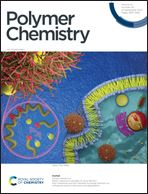Impact of cyclization and dendronization on multi-tunable thermoresponsive behaviors of polyacrylamide copolymers†
Abstract
Topological constraints can play a crucial role in the thermoresponsive behaviors of architectural polymers. To reveal phase transitions under confined conditions, two pairs of linear and cyclic polyacrylamide-type thermoresponsive heterofunctional-dendron-bearing polymers (THDPs) with pH-responsive dimethylamino groups, namely, PNADA and PNADD, are designed. Thermoresponsive behaviors can be efficiently regulated by topology, composition, solvent isotopes and pH. Despite the cyclization-induced increase in the LCST-type cloud point (Tc,l) of PNADA solutions, cyclic PNADD solutions only present a medium Tc,l as compared with the linear analogue with dual LCSTs at pH 7.5 and 10 due to a more confined microenvironment. A solvent switch can alter the type and temperature of phase transitions, in which linear PNADD shows unusual dual LCST and UCST behavior in D2O. The incorporation of bulky dendrons into cyclic architecture can endow subunits with remarkably confined mobility and a distinct response upon heating, during which morphological transitions among spheres, vesicles, nanoribbons and lamellae occur. Owing to their abundant compositions and functions, topologically confined THDPs can hold great promise in the on-demand regulation of phase transitions and nanostructures.



 Please wait while we load your content...
Please wait while we load your content...